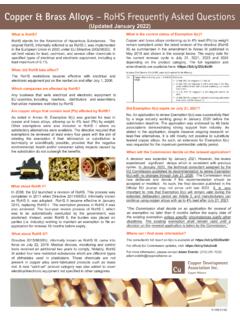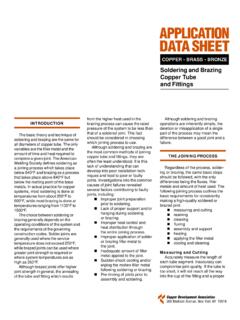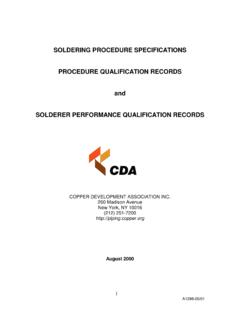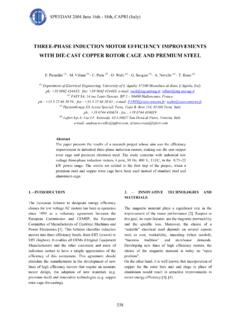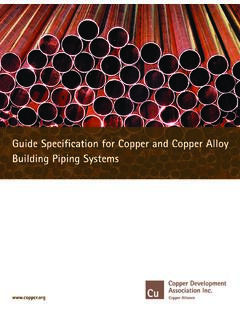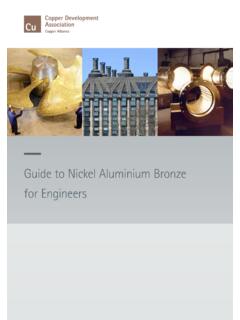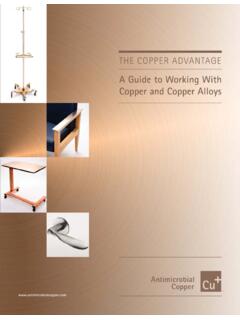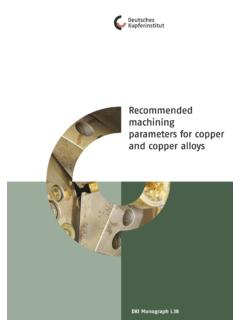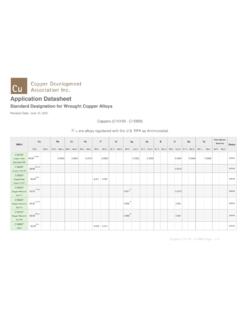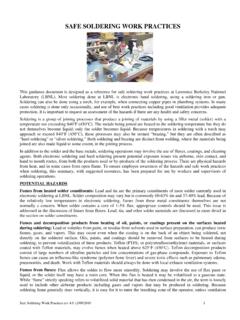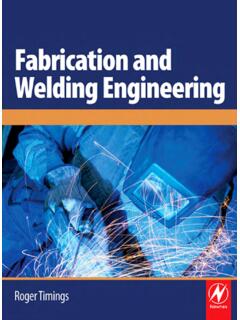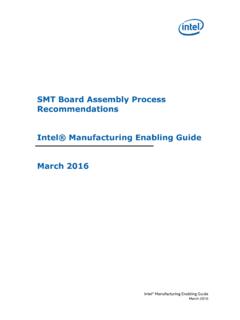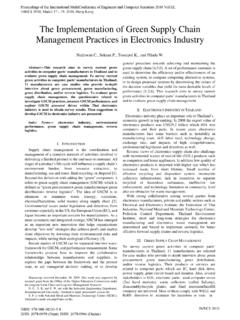Transcription of Soldering and brazing of copper and copper alloys
1 Soldering and brazingof copper and copper alloys2 | Introduction 42. material engineering fundamentals Fundamentals of copper and copper alloys Filler materials Soft solder brazing filler metals Soldering or brazing pure copper 16 Soldering / brazing copper alloys 18 Low-alloyed copper alloys High-alloyed copper alloys 22 3. Design suitability for Soldering / brazing 26 4. Soldering and brazing methods 29 The Soldering / brazing principle Surface preparation Surface activation Fluxes Protective atmosphere / Shielding gases 35 Applying the solder or brazing filler metal Soldering and brazing techniques Soldering with Soldering iron Dip bath Soldering or brazing Flame Soldering or brazing Furnace Soldering or brazing 40 Electric resistance Soldering or brazing Induction Soldering or brazing Electron beam brazing Arc brazing Laser beam Soldering or brazing 46 Contents5.
2 Quality assurance 476. Case studies Hot-air solder levelling of printed circuit boards Strip tinning Fabricating heat exchangers from copper Manufacture of compact high-performance radiators from copper 497. Terminology 508. Appendix 51 References 57 Index of figures 58 Index of tables 59 AbbreviationsNd:YAG laser Neodymium-doped yttrium aluminium garnet laserSMD Surface-mounted devicePVD Physical vapour depositionRoHS Restriction of (the use of certain) Hazardous Substances EG Europ ische GemeinschaftEC European CommunityMIG Metal inert gas processTIG Tungsten inert gas processDVGW German Technical and Scientific Association for Gas and Water [Deutsche Vereinigung des Gas- und Wasserfaches]Chemical elements and compoundsAg SilverAl AluminiumAr ArgonBe BerylliumC CarbonCO2 Carbon dioxideCr ChromiumCu CopperH2 HydrogenH2O WaterHF Hydrofluoric acidMn ManganeseNi NickelO2 OxygenP PhosphorusPb LeadS SulphurSb AntimonySi SiliconSn TinTe TelluriumZn ZincZr ZirconiumList of | 3 With increasing industrialisation, other properties of copper became important, such as its excellent electrical and thermal conductivity and its resistance to atmospheric corrosion, and its generally high resistance to chemical can form alloys with many different metals and a large numbers of alloy systems are now available that enable mechanical and technological properties, such as hardness, tensile strength, yield strength, chemical resistance, resistance to wear.
3 To be modified in a controlled their particular physical and mechanical characteristics are taken into account, copper and the majority of copper alloys show a high degree of solderability or brazeability. Fabrication process variables, such as the particular Soldering or brazing technique to be used, the choice of filler material and any preparative or after-treatment procedures, need to be carefully selected on the basis of the materials to be joined. The factors that influence the solderability or brazeability of a material are shown in figure 1 and need to be taken into account both individually and in component is considered solderable or brazeable if the parent material is suitable for Soldering or brazing , and one or more Soldering or brazing techniques can be applied, and if the parts to be joined are designed so as to facilitate the Soldering / brazing process and to ensure that the soldered/brazed part is safe under the conditions in which it is to be used [1].
4 This booklet aims to reflect the current state of Soldering and brazing copper and copper alloys in industrial applications, but does not claim to be complete. As research and development work in this field is continuing, enquiries should be directed to the German copper Institute or corre-sponding is a material that has been used by man for thousands of years because of its special properties. As a native metal, one that is also found naturally in its pure me-tallic form, copper was used early in human history because of its good malleability and formability and because of its colour. copper thus became man s first working Introduction4 | | 5 Chemical and metallurgical properties Chemical composition Oxidation behaviour Corrosion behaviour Diffusion and solubility characteristics Ability to undergo precipitation heat treatment MicrostructurePhysical properties Wettability Solidus temperature Thermal expansion Thermal conductivity.
5 Specific heat capacityMechanical properties Strength and formability Residual stressesMaterial suitability for Soldering /brazingDesign suitability for Soldering /brazingSolderability or brazeability of a workpieceManufacturing suitability for Soldering / brazing Dimensional stability of the parts to be joined Condition of surfaces Surface coating Shape and size of the assembly gap or the gap/joint to soldered or brazed Location of inserted solder/filler metal and air vents Fastening of parts to be joined Solder or brazing filler metal Materials and methods of oxide removal Soldering or brazing cycle Soldering / brazing rate Post annealing treatment Joint clean-up Joint testing Location of Soldering / brazing seam or zone Cross-sectional ratios Notch effect Seam irregularities Static or dynamic loads Stresses in the region of the soldered/brazed joint Loading rate Loading temperature Load-transfer mediumFigure 1 Definition of solderability/brazeability (see [2])Like welding, Soldering and brazing are important methods of thermally joining materials, typically metals.
6 As it is the resulting joint irrespective of the method used to make it that ultimately deter-mines the properties of the part being fabricated, the two methods are classified (see [3]) in terms of the chemical nature of the joint, the chemical composi-tion of the parent metal (or metals) and the type of filler material used, if any. Both welding and Soldering / brazing lead to the formation of a metallic joint, however the chemical composition of these joints differ. Whereas a welded joint has the same chemical composition as that of the two identical parent metals being joined, the use of a filler alloy in a Soldering or brazing procedure means that the soldered or brazed joint has a different chemical composition to that of the parent materials. A soldered or brazed joint comprises the heat-affected parent materials, the diffusion/transition phase and the solder/braze metal. The solder metal or braze metal can be formed by the action of heat either with or without a filler and brazing do not involve any melting of the parent material , of the surfaces to be joined.
7 Instead, the workpieces are joined by introducing an additional molten metal, the filler metal , possibly in combination with a flux and/or in a protective gas atmosphere [4].Some of the advantages of Soldering or brazing compared to other joining methods are: [5] Soldering / brazing enables dissimilar materials to be joined; as less heat is applied in the joining process, soldered or brazed parts tend to exhibit greater dimensional accuracy and less distortion; multiple soldered/brazed joints can be created on a single workpiece in a single operation; intricate assemblies can be soldered/brazed without damage; soldered/brazed joints exhibit good thermal and electrical conductivity; and as Soldering / brazing directs less heat into the joint than welding, there is less residual stress and distortion in the following points should, however, be noted: the strength of a soldered or brazed joint is typically not as great as that of the parent material ; the parent metal and the solder/braze metal have different chemical potentials; there is a risk of chemical corrosion due to the presence of flux residues.
8 Design restrictions may be relevant because of factors such as narrow Soldering / brazing gaps and tight dimen-sional tolerances at the joint. Extensive preparatory and after-treatment proce-dures are often required, such as degreas-ing, etching, removal of flux residues, etc. [6]. The related joining techniques of Soldering and brazing are distinguished in the DIN ISO 857-2 standard by the liquidus temperature of the filler metal used. In Soldering , the liquidus temperature of the filler metal is below 450 C; in brazing it is above 450 C. Up until February 2007, high-temperature brazing (at temperatures above 900 C) was defined in the earlier and now withdrawn DIN 8505 standard. Today, high-temperature brazing is classified simply as brazing . 6 | 2 Example of a brazed copper -silver joint. (Note that no filler metal was used; the alloy Ag72Cu28 is formed by diffusion during the brazing process.)AgCuAg72Cu28 brazed metalBrazed jointBrazing seamDiffusion zone Heat-affected zoneBrazed metal | 7 Both physical and chemical processes are involved in Soldering / brazing .
9 Soldering / brazing joints are created through surface chemical reactions and diffusional processes of the liquid filler metal and the solid parent material . The Soldering / brazing mechanism comprises the following steps: [7] of the parts to be activation, by a flux or a shielding of filler metal and wetting the molten filler metal flows into the gap between the mating surfaces or spreads across the surface of the solder/braze metal through (physical and chemical) inter-action between the molten filler and the parent of the liquid solder/braze is applied to melt the filler metal and any flux being used. The method used to heat the parts to be joined will depend on the type of join to be created (see Section ). Fluxes serve to activate the surfaces to be joined. The molten filler metal will only be able to wet the surfaces to be joined if they are clean and free from oil, grease and other surface deposits. The wetting process is also influenced by capillary action of the molten filler, adhesion and diffusion processes between the liquid phase and the parent material .
10 Figure 3 shows the wetting of the surface by the molten filler metal. The contact angle is determined by the interaction between the three surface tensions involved in the wetting process: 1,2 (vapour-liquid surface tension), 1,3 (vapour-solid surface tension) and 2,3 (liquid-solid surface tension).1 Surrounding vapour phase2 Molten filler 3 Parent material Contact angle 1,2 Surface tension between molten filler and the surrounding atmosphere 1,3 Surface tension between the solid base metal and the surrounding atmosphere 2,3 Surface tension between molten filler and solid base metalFigure 3 - Wetting of a metallic surface with a liquid filler metal [7]The smaller the contact angle, the better the wetting of the surface. Table 1 defines the three regimes perfect wetting , adequate wetting and dewetting in terms of the corresponding contact Soldering or brazing , alloying elements from the filler metal can be found in the parent material and alloying elements from the parent metal are detectable in the filler metal.
